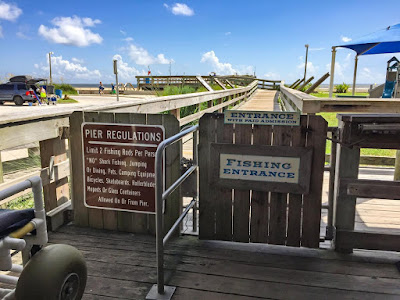When my fiance and I stay in St. Augustine, we always stay on Anastasia Island, where St. Augustine Beach is actually located. We love being within walking distance of the beach and the pier. In fact, St. Johns County Ocean & Fishing Pier is often one of our first and most regular stops. There's a lot of personal history for my fiance there, as his grandparents regularly visited and had their photographs posted up in the pier gift shop for many, many years (it actually might still be there, I forgot to check on our last visit).
There's also a lot of history in general regarding the pier, just as there is with everything in St. Augustine. In the 1800s, Anastasia Island was actually known as South Beach, and from the city of St. Augustine, beachgoers would take a ferry over the Matanzas River to the Island, then a donkey cart over dirt roads to the lighthouse. Later, a wooden bridge was built over the river, and visitors took the South Beach Railroad from the bridge to the beach.
In 1937, the county found an opportunity in the New Deal, and received funds to develop a recreational complex, including a seawall, boardwalk, and fishing pier, all to be flanked by a pair of hotels. Construction of the pier was completed in July of 1939. At 1,300 feet, it was reputed to extend further into the ocean than any other pier on the Atlantic seaboard.
Unfortunately, that reputation was short-lived. A tropical storm wiped out 500 feet of the pier and damaged another 500 feet in October of the same year. When it was rebuilt, a T-shape was added at the end, and the pier was shortened to 800 feet.
Soon after, during World War II, the Coast Guard took control of the beach just after the attack at Pearl Harbor. No one was permitted on Anastasia Island after dark without identification, and those few who were allowed on the island at night had to drive with their headlights off while the Coast Guard patrolled the beach in the darkness for enemy submarines, boats, and aircraft.
Later, in the fall of 1962, a nor'easter rendered the original pier structurally unsound as the beach suffered dreadful erosion.
In the summer of 1964, the Southern Christian Leadership Conference held civil rights demonstrations known as "swim-ins" or "wade-ins," in an attempt to begin to integrate the all-white beaches. It's said by historians that this particular tactic was unique to St. Augustine Beach.
In the fall of 1964, Hurricane Dora was the first hurricane in 50 years to hit St. Augustine directly. The end of the pier was ripped loose, and waves crashed over the seawall into the coquina buildings. The pier remained open for fishing, but continued beach erosion and the damaged buildings made the area unattractive to tourists and visitors.
In 1973, a nor'easter caused more erosion of the beach, threatening the seawall. Another struck in 1978, taking another piece off the end of the pier and causing extensive damage to the pilings. Concrete shields were placed around them, but they were damaged by Hurricane David later that same year.
In 1984, a concrete bolstered pier opened up to replace the New Deal pier. This new pier was 1,000 feet long.
The covered pavilion, which now hosts concerts and events, was built in 1998. After this began the era of sand renourishment, and from 2001 to 2012, millions of yards of sand were added to the beach in three large installment projects. These projects were part of a 50 year commitment by the U.S. Army Corps of Engineers to keep the beach renourished.
In 2002, the pier was yet again rebuilt as part of another U.S. Army Corps of Engineers project, this one to restore the coastline. The county approved funding for repairs in 2011 to extend the life of the pier for another ten years, and in 2020, as the Coronavirus pandemic was beginning, the pier was closed for several months for repairs. Improvements and rehabilitation were done to the pier and the approaching boardwalk.
Today, the pier still sits at the border between Anastasia State Park and St. Augustine Beach. It offers beach access, a splash park, covered pavilion where live entertainment happens, showers, bathrooms, sand volleyball, and bocce courts. The pier is within walking distance of beach and swim apparel shops, oceanside restaurants, and hotels.
Swimming and surfing aren't permitted within 400 feet of the pier, and there is a small fee for pier access and to fish from the pier between 7am and 9pm, which can be paid inside the gift shop. After 9pm, the gate at the entrance of the boardwalk is opened up and access is free.
During my last trip to St. Augustine, we stayed just across Beach Boulevard from the pier, and the last thing I did every night before turning in was to walk out to the end of the pier. There's nothing that compares to standing out there, a thousand feet into the ocean in the dark, listening to the sound of the waves crashing against the pilings and the shore with nothing but darkness extending out for miles before you. You realize how very small you are, and at the same time, how completely connected.
If you're staying in the area but you aren't at a hotel with its own beach access, this will be your access point to the beach. Although the pier is simple and laid back, it's worth your time, even if you don't fish. I've seen dolphins frolicking in the waves, sharks caught by fishermen late at night, large birds swooping over the surface of the ocean to catch fish - and sitting out at the end of the pier late at night is a calming experience like no other.
St. Johns County Ocean & Fishing Pier350 A1A Beach Boulevard
St. Augustine, FL 32080









Comments
Post a Comment